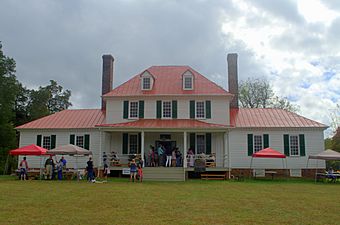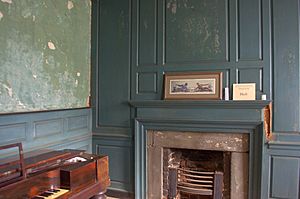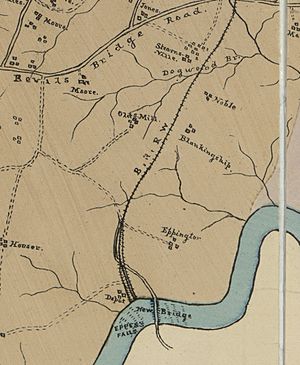Eppington facts for kids
|
Eppington
|
|

Front of the house, pictured in 2017
|
|
| Location | South of the junction of VA 621 and 602, near Winterpock, Virginia |
|---|---|
| Area | 1,750 acres (710 ha) |
| Built | c. 1768 |
| Architectural style | Georgian |
| NRHP reference No. | 69000230 |
Quick facts for kids Significant dates |
|
| Added to NRHP | November 12, 1969 |
Eppington is a historic plantation house located near Winterpock, Chesterfield County, Virginia. It was built around 1768. This beautiful old house shows off the Georgian style of architecture. It has a main part with a sloped roof and two smaller parts on the sides. Eppington was added to the National Register of Historic Places in 1969 because of its important history.
Eppington's History
The Eppes and Jeffersons
Francis Eppes built Eppington. He was related to Martha Jefferson, who was the wife of Thomas Jefferson. Thomas Jefferson was a very important person in American history. After Martha Jefferson passed away, Francis Eppes and his wife helped raise Jefferson's two daughters. This happened while their father was serving as a minister in France.
Charles Eppes, another family member, sent samples of American trees to Thomas Jefferson in France. These trees included Bald Cypress, Eastern Red Cedar, Southern Magnolia, and Wax-myrtle. He also sent hams from Monticello, Jefferson's home. The daughters of the Eppes family studied nature and farming. They kept notes on when crops were ready and when birds like the Eastern whip-poor-will arrived and started singing. One of the daughters, Lucy Elizabeth, passed away in 1784 and was buried at Eppington. Mary (Polly) Jefferson, another daughter, married her cousin, John Wayles Eppes, in 1797. She spent a lot of her time at Eppington.
In 1790, many people lived and worked at Eppington. This included 124 enslaved individuals and two white overseers. The area near the main house was a service yard. This is where enslaved people did work like smoking country hams, milking cows, making butter, and getting water from a well. A fence seemed to separate the enslaved people who worked in the fields from those who worked in the house. The service yard was hidden from visitors by pretty gardens, fruit orchards, and lawns. The hard work of the enslaved people helped the plantation become very wealthy until the American Civil War.
As early as 1806, there was a school building on the property. Later, by the mid-1800s, this building was changed into a kitchen. It replaced an older kitchen building.
Archibald Thweatt's Time
Archibald Thweatt began to buy Eppington in December 1812. There were dangerous waterfalls at Eppington called Epps Falls. In 1819, the Virginia General Assembly allowed a company to build a dam and locks around these falls. This helped boats pass safely. Archibald Thweatt, as the owner of Eppington, received money for any damage caused by this building. He and his family were also allowed to build a grist mill on the dam. A grist mill is a place where grain is ground into flour. Archibald Thweatt also raised Merino sheep for their wool. In 1819, he made an agreement about land. This agreement was important to keep a road open that went from Richmond to Petersburg.
When the Upper Appomattox Canal Navigation System was finished, farmers nearby could ship their crops from the docks at Eppington. There were large places for loading goods onto boats. When coal was first mined at the Clover Hill Pits in 1837, it was taken by mule, and later by train, to the docks at Epps Falls. A boat that could carry seven tons of coal made a four-day trip to Petersburg and back. This trip cost two dollars and thirty-eight cents. Train service to the docks stopped when the Clover Hill Railroad was built to the James River. But it was added back later when the Brighthope Railway was expanded in 1881.





